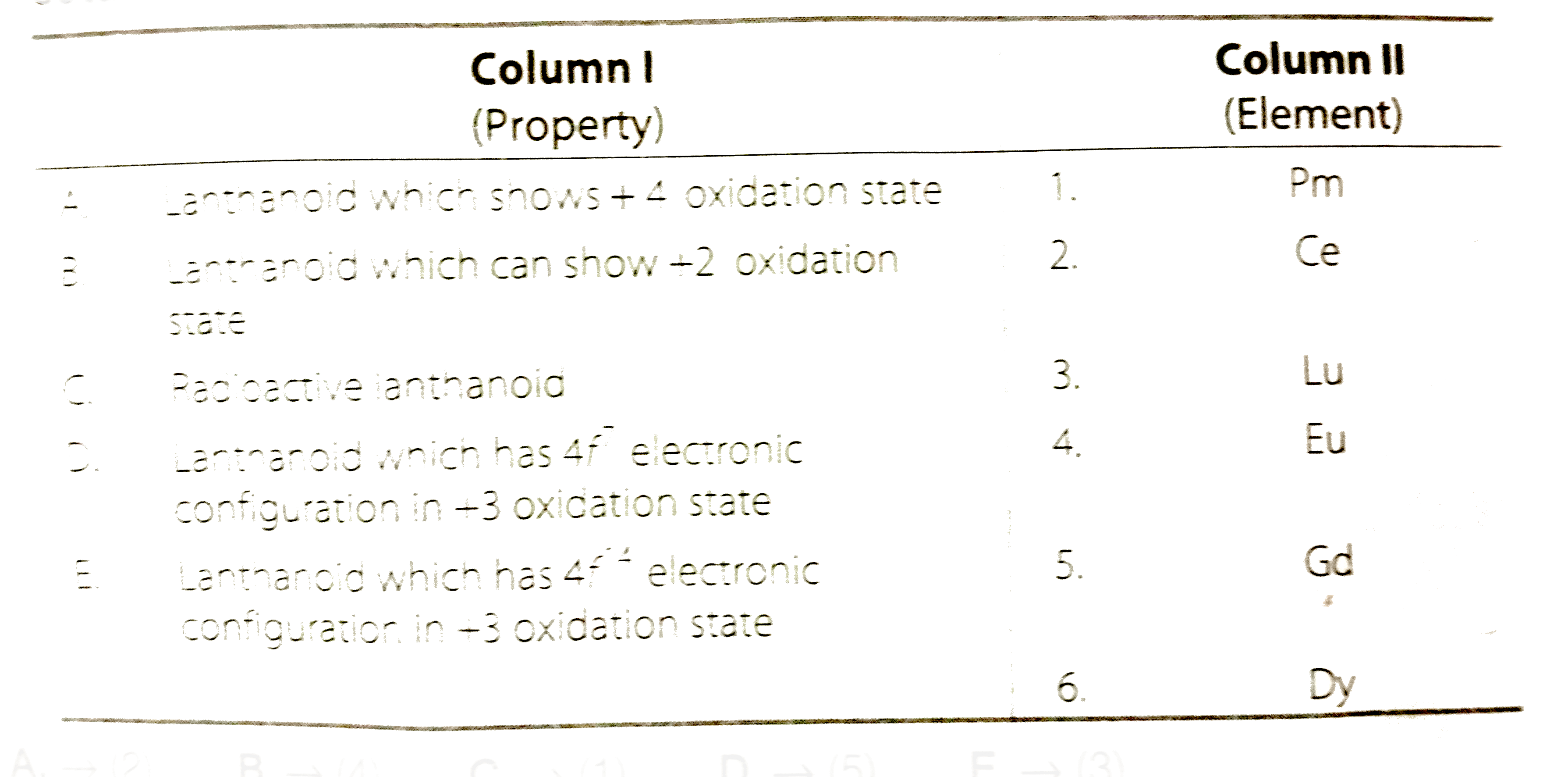Match the properties given in Colunmn I with the emtals given in Column II.
Column I (Property)Column II ( Metal)(i)Element with higher second ionisation enthalpy (a)Co(ii)Element with highest third ionisation enthalpy(b)Cr(iii)M in M(CO)6is(c)Cu(iv)Element with highest heat of atomisation(d)Zn(e)Ni
The correct Answer is:(i)→(c),(ii)→(d),(iii)→(b),(iv)→(e)
To solve the problem of matching the properties in Column I with the metals in Column II, we will analyze each property one by one.
1. Element with higher second ionisation enthalpy:
- To find the element with the highest second ionisation enthalpy, we need to consider the electronic configurations of the metals.
- Copper (Cu) has the electronic configuration of (Ar) 3d10 4s1. After removing one electron, the configuration becomes (Ar) 3d10. Removing a second electron from a fully filled 3d subshell is energetically unfavorable, leading to a high second ionisation enthalpy.
- Match: (i) → (c) Cu
2. Element with highest third ionisation enthalpy:
- For the highest third ionisation enthalpy, we look at Zinc (Zn) which has the configuration (Ar) 3d10 4s2. After removing two electrons, the configuration is again (Ar) 3d10. Removing a third electron from a fully filled 3d subshell is also unfavorable, resulting in a high third ionisation enthalpy.
- Match: (ii) → (d) Zn
3. M in M(CO)6 is:
- In the complex M(CO)6, we need to identify the metal that forms a stable carbonyl complex. Among the given options, Chromium (Cr) is known to form stable carbonyl complexes.
- Match: (iii) → (b) Cr
4. Element with highest heat of atomisation:
- The heat of atomisation generally increases with the number of unpaired electrons and the strength of metallic bonds. Nickel (Ni) is known to have a relatively high heat of atomisation among the given metals.
- Match: (iv) → (e) Ni
Final Matches:
- (i) → (c) Cu
- (ii) → (d) Zn
- (iii) → (b) Cr
- (iv) → (e) Ni
- To find the element with the highest second ionisation enthalpy, we need to consider the electronic configurations of the metals.
- Copper (Cu) has the electronic configuration of (Ar) 3d10 4s1. After removing one electron, the configuration becomes (Ar) 3d10. Removing a second electron from a fully filled 3d subshell is energetically unfavorable, leading to a high second ionisation enthalpy.
- Match: (i) → (c) Cu
- For the highest third ionisation enthalpy, we look at Zinc (Zn) which has the configuration (Ar) 3d10 4s2. After removing two electrons, the configuration is again (Ar) 3d10. Removing a third electron from a fully filled 3d subshell is also unfavorable, resulting in a high third ionisation enthalpy.
- Match: (ii) → (d) Zn
- In the complex M(CO)6, we need to identify the metal that forms a stable carbonyl complex. Among the given options, Chromium (Cr) is known to form stable carbonyl complexes.
- Match: (iii) → (b) Cr
- The heat of atomisation generally increases with the number of unpaired electrons and the strength of metallic bonds. Nickel (Ni) is known to have a relatively high heat of atomisation among the given metals.
- Match: (iv) → (e) Ni
- (i) → (c) Cu
- (ii) → (d) Zn
- (iii) → (b) Cr
- (iv) → (e) Ni
Topper's Solved these Questions
- D- AND F-BLOCK ELEMENTSBOOK - PRADEEPCHAPTER - D- AND F-BLOCK ELEMENTSEXERCISE - ASSERTION AND REASON TYPE QUESTIONS
5 Videos
- D- AND F-BLOCK ELEMENTSBOOK - PRADEEPCHAPTER - D- AND F-BLOCK ELEMENTSEXERCISE - LONG ANSWER QUESTIONS
8 Videos
- D- AND F-BLOCK ELEMENTSBOOK - PRADEEPCHAPTER - D- AND F-BLOCK ELEMENTSEXERCISE - NCERT EXEMPLAR PROBLEMS(SHORT ANSWER QUESTIONS )
20 Videos
- CORDINATION COMPOUNDSBOOK - PRADEEPCHAPTER - CORDINATION COMPOUNDSEXERCISE - Important Questions
28 Videos
- ELECTROCHEMISTRYBOOK - PRADEEPCHAPTER - ELECTROCHEMISTRYEXERCISE - IMPORTANT QUESTIONS FOR BOARD EXAMINATION
25 Videos
Similar Questions
Knowledge Check
Metch the properties given in column I with the metals given in column II
 Ai−c,ii−d,iii−e,iv−aBi−c,ii−d,iii−b,iv−aCi−c,ii−d,iii−a,iv−eDi−d,ii−c,iii−a,iv−e
Ai−c,ii−d,iii−e,iv−aBi−c,ii−d,iii−b,iv−aCi−c,ii−d,iii−a,iv−eDi−d,ii−c,iii−a,iv−e
Match the properties given in Column I with the metals given in Column II.

View SolutionMatch the properties given in column I with the metals given in Column II.

View SolutionMatch the properties given in column I with the metals given in column II

View SolutionMatch the properties given in column I with the metals given in column II

View SolutionMatch the properties given in column I with the element given in column II

View SolutionMatch the property given in Column I with the element given in Column II.

View SolutionMatch the property given in Column I with the element given in Column II.

View Solution


